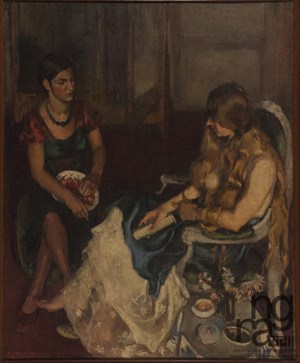
Since time immemorial, the portrayal of women in art has often been confined to the idealised perfection of physical appearance, emphasising alluring faces associated with fertility and prosperity. However, this limited narrative failed to encapsulate the complexities and realities of women's lives.
The entrance of Amrita Sher-Gil onto the artistic stage in the 1920s was a
groundbreaking moment that would reshape the representation of women in the world of Indian art. Let’s delve into the life and works of the luminary on the occasion of her 111th birth anniversary.
Born in Hungary in 1931, Amrita Sher-Gil displayed a prodigious talent for drawing from a young age. By 16, she had enrolled in L'Académie de la Grande Chaumière, and later she continued her artistic journey at the prestigious École des Beaux-Arts in Paris. Sher-Gil's early body of work reads like visual poetry, capturing the intricacies of her intimate relationships with both herself and the women in her life. With a keen eye for detail, she painted herself and her close friends in a myriad of emotions, immortalising the seemingly ordinary yet profound moments of their lives.
Her time in Paris marked a significant chapter in Sher-Gil's artistic exploration, where she created numerous portraits and figure studies of her friends. One of her early achievements in Paris was a painting titled "Young Girls" featuring her sister Indira and friend Denise Proutaux. In this piece, Sher-Gil masterfully depicted the contrast between boldness and demureness by presenting her sister in a dress while portraying her friend topless. This work, now part of the national collection, earned her accolades, including a gold medal at the Grand Salon in Paris, making her the youngest and the only Asian member ever to join the Salon.
Upon returning to India in 1934, Sher-Gil underwent a notable stylistic transformation, but her dedication to portraying women remained unwavering. In her own words, she articulated that her artistic goal was to "paint those silent images of infinite submission and patience, to depict
their angular brown bodies strangely beautiful in their ugliness, to reproduce on canvas the impression their sad eyes created on me". Her technique evolved to become more"fundamentally Indian", reflecting a deep connection with her cultural roots.
Sher-Gil's commitment to portraying the diverse experiences of women extended to a series of self-portraits, each capturing different moods and moments in her life. In "A Farkas Khan Leanya (The Daughter Of The Wolf Khan)," she presented herself as a native princess, showcasing the
versatility of her artistic expression. In another poignant self-portrait titled "Sorrow," she skillfully conveyed her own anguished expression, providing viewers with a glimpse into the emotional depth of her art.
The impact of Amrita Sher-Gil's energy and casual confidence reverberated through generations of male and female artists. Yet, it was her profound examination of femininity that laid the foundation for a new era in Indian art. Beyond merely influencing artists, Sher-Gil's work facilitated the emergence of art created by women, focused on the nuanced exploration of women's experiences and identities.
Amrita Sher-Gil's legacy endures as a testament to the transformative power of art to challenge and redefine cultural narratives. Through her lens, women were no longer passive subjects but active participants in the artistic discourse, contributing to a more inclusive and diverse representation in Indian art. Sher-Gil's exploration of the human experience, particularly that of women, carved a path for a richer, more nuanced understanding of gender and identity in the cultural fabric of India.
- Authored by Sneha Gautam, Senior Vice President at AstaGuru Auction House
Main Image :Young Girls, Oil on Canvas. Photo Credit NGMA New Delhi

ArtDependence Magazine is an international magazine covering all spheres of contemporary art, as well as modern and classical art.
ArtDependence features the latest art news, highlighting interviews with today’s most influential artists, galleries, curators, collectors, fair directors and individuals at the axis of the arts.
The magazine also covers series of articles and reviews on critical art events, new publications and other foremost happenings in the art world.
If you would like to submit events or editorial content to ArtDependence Magazine, please feel free to reach the magazine via the contact page.